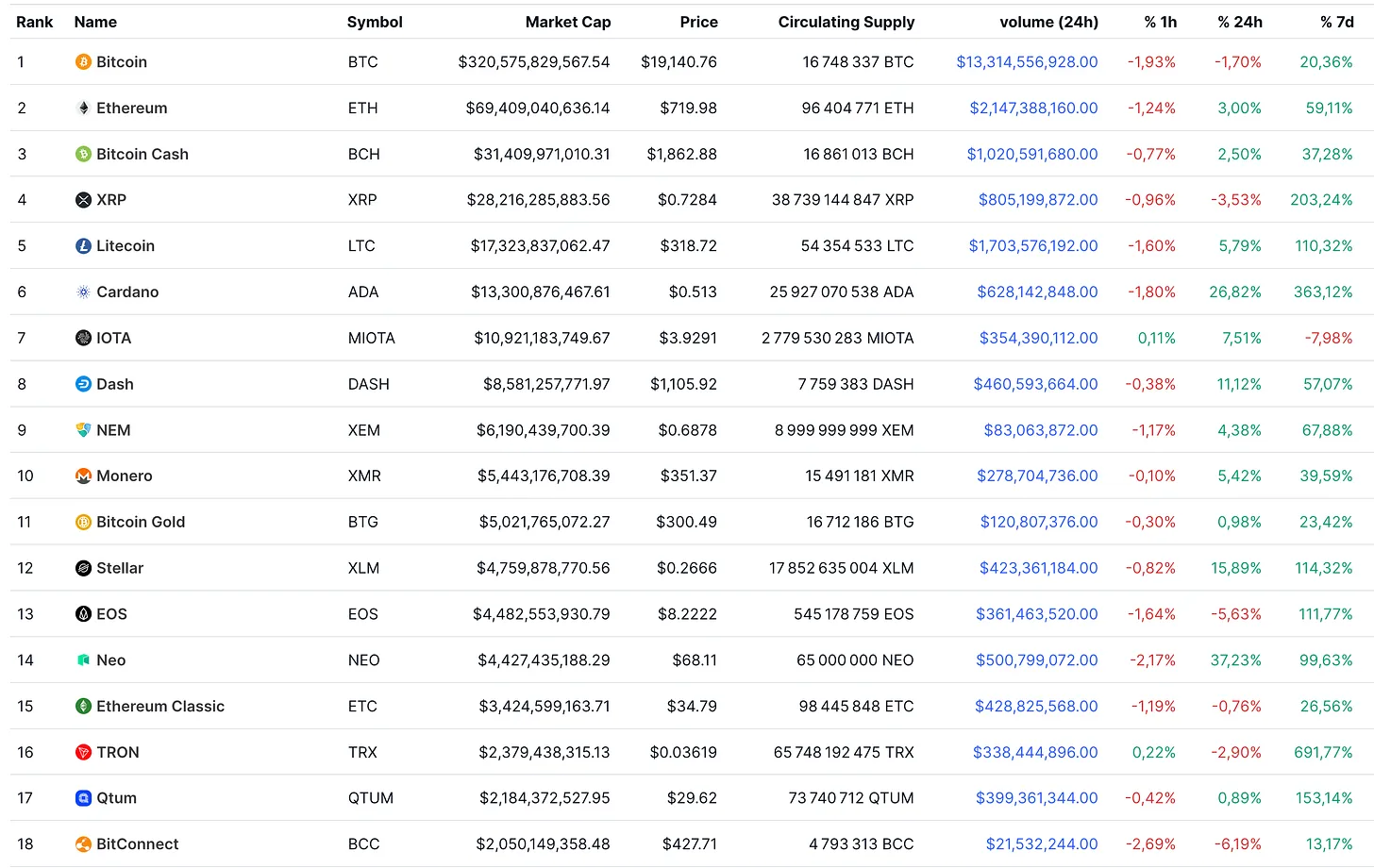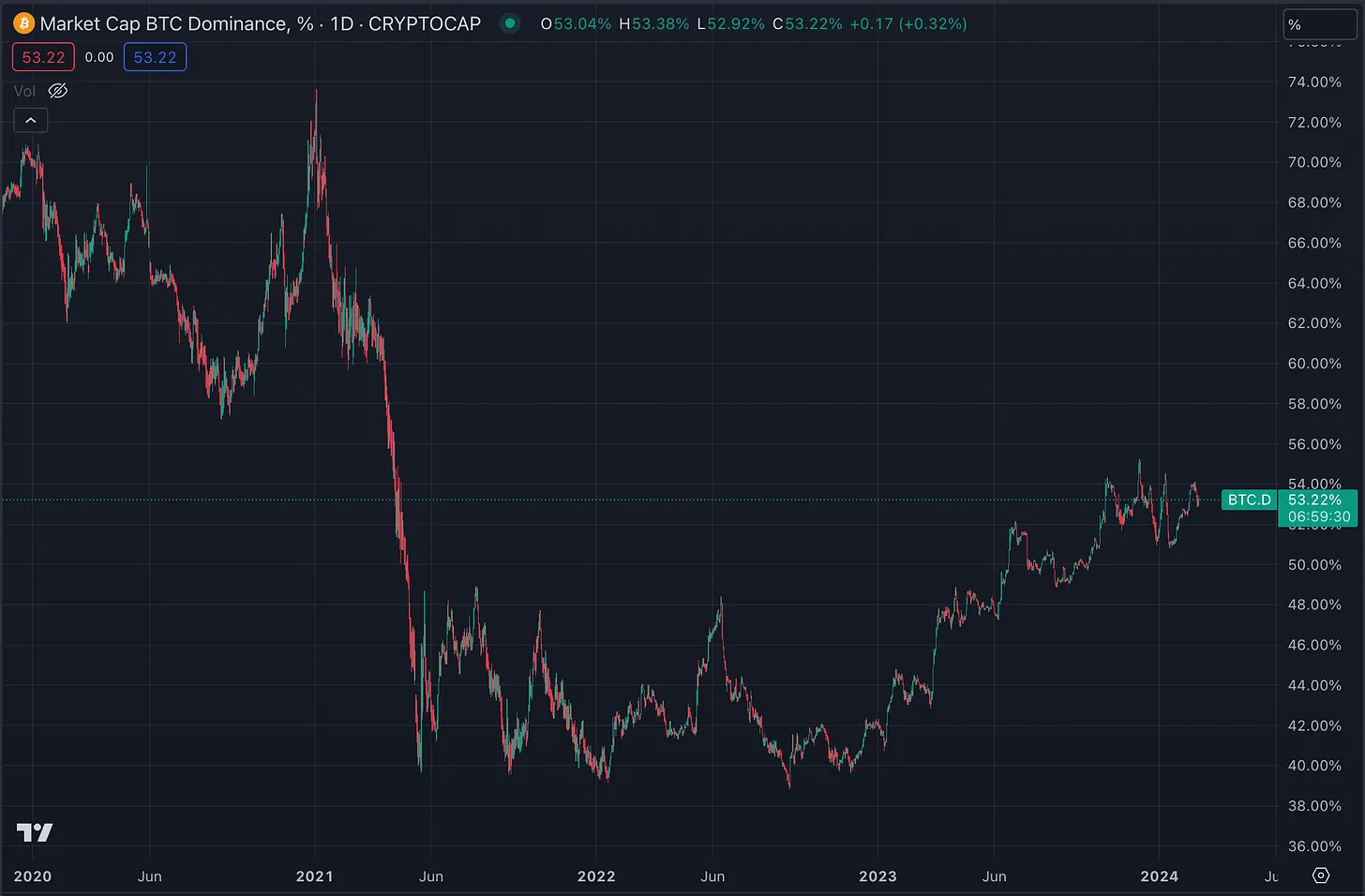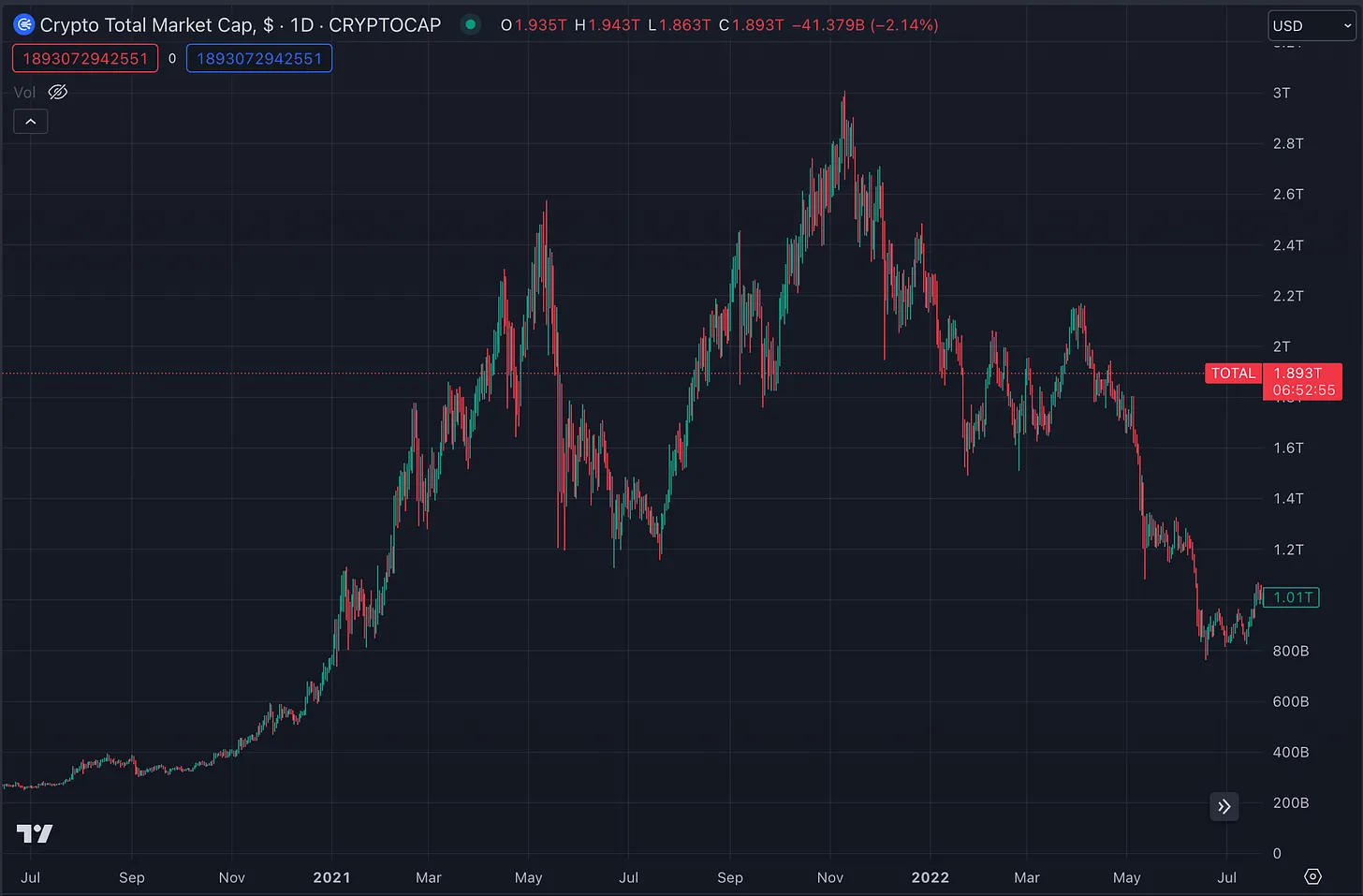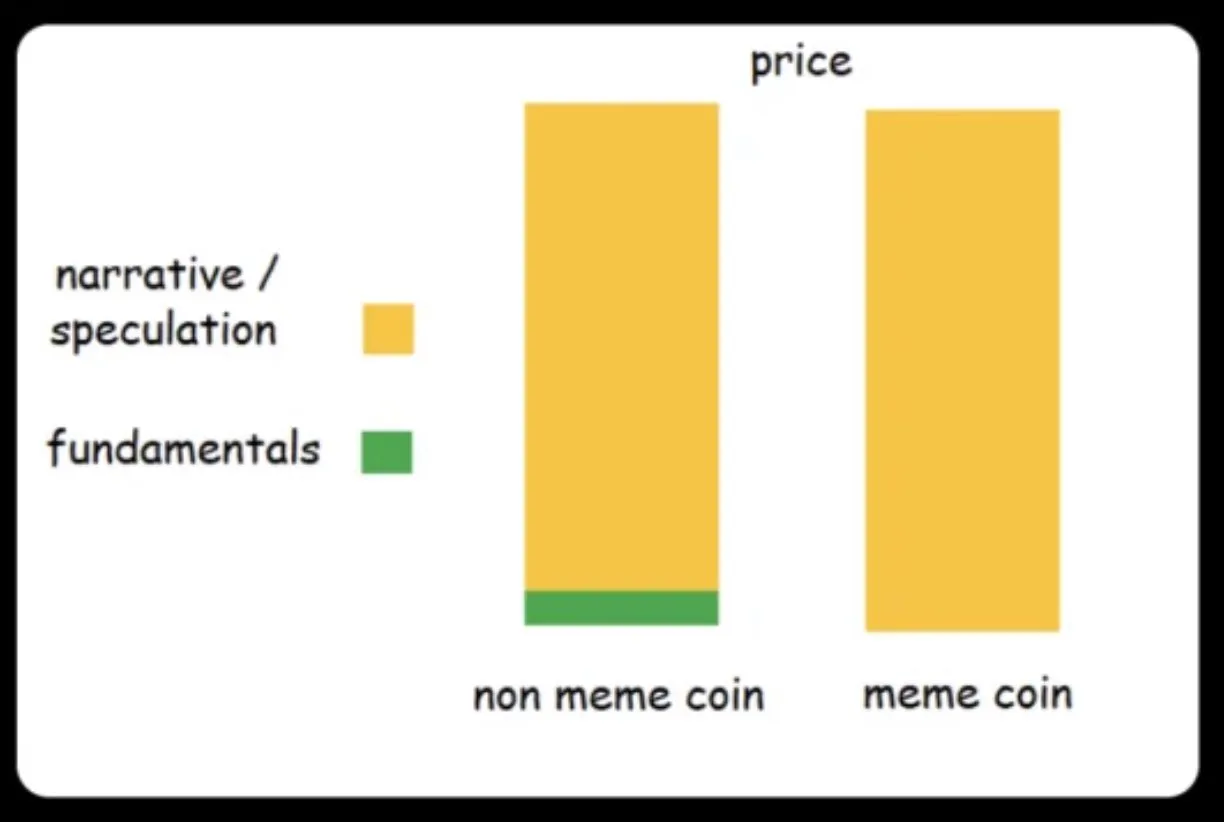How to catch coins that can increase 20 to 100 times in the next bull market?
Original Title: How to catch a few 20x to 100x coins during the next bull run?
Original Author: VIKTOR
Original Compilation: 深潮 TechFlow
I spent quite a bit of time researching the last bull market, the different narratives that were popular at the time, the rotation for profit maximization, the best-performing tokens of 2021, and the logic behind their massive gains.
This new cycle will not be exactly the same as the previous one, but we should remember many lessons, as history tends to repeat itself, especially in financial markets, where much of the prosperity comes from the way the human brain thinks, which will never change. Let's get straight to the point.
General Experiences of a Bull Market
New coins perform well, old coins perform poorly
A notable trend during the 2021 bull market was the poor performance of old coins, with almost none of the coins from the 2018 cycle performing well in 2021.
Ripple (XRP), Stellar Lumens (XLM), Bitcoin Cash (BCH), NEO, XEM, IOTA, EOS, Dash, Monero (XMR), Zcash (ZEC), and Tron (TRX) never reached their previous all-time highs (in USD) again, and they have basically only declined relative to BTC since 2018.
Of course, aside from BTC and ETH, the only good performers among major old coins were BNB, Cardano (ADA), Ethereum Classic (ETC), and of course DOGE.
This is a screenshot of CoinMarketCap's rankings from December 2017. I strongly recommend checking several historical snapshots to help you understand how the cryptocurrency market "rotates."

Most coins underperform BTC before the bull market truly begins
When we are in the middle of a bear market, thinking we are close to the bottom, it is clearly the best time to buy BTC and ETH and hold them until the next bull market.
But under the same logic, you might also be tempted to buy altcoins because they have a high beta relative to BTC and should perform better. While this is indeed the case for some altcoins, it was not entirely true in the last bull market.
Most altcoins underperformed Bitcoin during the BTC rise at the end of 2020, only to suddenly take off at the beginning of 2021.
The good news is that by holding BTC and ETH until the bull market starts, you did not really miss out on the excess returns.
If history repeats itself, this is what we should expect: BTC (and perhaps ETH) should have a period of self-launch, while altcoins lag behind, BTC's market share increases, and then suddenly the rotation begins, at which point altcoins start to soar.
However, I don't think this is exactly what has happened or will happen: what we've seen over the past few months is that $BTC has risen alongside BTC's dominance, just like in 2020, but this time from June 2023 to now, we have seen many tokens outperform BTC.

BTC Market Share
My explanation is that for long-term investors, the bottom bought in November 2022 was $BTC (and $ETH, even though in hindsight not touching ETH in 2023 was the best idea), while the right time to buy the correct altcoins was around June 2023.
There is a lot of variance in altcoin performance: $ETH underperformed $BTC in 2023, some old altcoins have also underperformed $BTC in the past few months, while certain altcoins have significantly outperformed the market.
That said, we have not yet seen the euphoric phase for altcoins, and I expect this to enter a full-blown euphoric phase when BTC breaks its previous all-time high ($69,000).
Most gains are concentrated within a few months
Most of the gains in these cryptocurrencies are concentrated over a relatively short period. Almost all performance occurs within a few months, especially for altcoins.
For example, in the last bull market, it was from January to May 2021, and then from August to November. The market was in a "only up" phase, where your new competitors were retail investors who had given up on cryptocurrencies for 3 years.
These are the key moments when you need to put 100% of your energy into the market. There is a famous GCR tweet that summarizes what you need to do during these periods:

Here are a few examples to make you realize how rapid and concentrated the rises can be:
$CHZ: 30x growth in one month from February to March 2021
$BNB: 8x growth in 20 days in February 2021
$DOT: 8x growth in two months from January to February 2021
$SUSHI: 6x growth in one month in January 2021
$AAVE: 6x growth in one month in January 2021
$HOT: 35x growth in two months from February to March 2021
$JOE: 60x growth in two weeks in August 2021
Don't let the PTSD from the bear market rob you of the opportunity to gain crazy returns during the bull market and altcoin season.
If this is your first market cycle, you are likely to enter the market too late, letting your investments soar at irrational valuations without taking profits in time, and then oscillating back and forth over many gains. However, if you are reading this article, you have likely already experienced the last cycle and survived the particularly brutal bear market of 2022. During the bear market, you must remain vigilant for every rise and be ready to short whenever an altcoin rises due to some catalyst. This behavior will be rewarded. However, everything changes completely in a bull market: coins rise higher than you can imagine. You must be ready to profit from it.
Here are a few examples of tokens that skyrocketed in a very short time in 2021, along with the massive valuations they reached:
In January 2021, $DOGE rose nearly 10x in one day when it was already a billion-dollar token.
$THETA's market cap rose from $1 billion to $12 billion in 3 months.
$RUNE's market cap increased from $200 million to nearly $5 billion in 5 months.
$FIL once reached an FDV close to $400 billion.
$ICP launched with an FDV of $250 billion.
$AXS's market cap rose from $200 million to $10 billion in 5 months, with an FDV peaking at $43 billion.
$GALA's market cap reached $5.4 billion at the peak in 2021, while at the beginning of the year, the project's market cap was only $5 million.
$TEL's market cap rose from $10 million to $3 billion (300x) in 5 months.

Evolution of Total Market Cap of Cryptocurrencies During the Last Bull Market
The main narratives of the 2021 cycle, along with the best returns:
DeFi 1.0:
DeFi became a new thing in cryptocurrency in 2020, providing new use cases and being a fresh concept from scratch. DeFi was the focus of the market in the summer of 2020, which is why it was called "DeFi Summer," and we can describe it as the beginning (or pre-beginning) of the bull market.
Adding a Ponzi economics aspect to the whole thing gives you the secret to achieving massive gains. The two biggest winners in DeFi with strong fundamentals were $AAVE and $SNX. From bottom to top, the gains for these were between 500x to 1000x. We can also mention $SUSHI, which grew 30x between November 2020 and March 2021.
Alt L1
L1 trading is the most enduring trade in cryptocurrency and one of the most valuable trades in the last cycle: the main winners of this trade were $SOL, $LUNA, $AVAX, but also included $FTM, $ADA, $BNB, $EGLD.
The market assigned a very high premium to Alt L1, meaning that on average, their value (market cap or FDV) was higher than other categories, such as applications. Once you understand this, you know you must engage with this narrative. It soon became clear that this was one of the themes of the 2021 bull market, as some of these were among the best-performing coins from the start until the Terra-Luna collapse in May 2022.
The lesson here is: once you understand what the main themes of the cycle are, you simply go with the flow. The second lesson is: Layer 1 network trades will never disappear. This was a dominant theme in 2021, but in fact, it was already the case in 2017, and it will again be so in 2023-2024.
Alt L1 Ecosystem Playbook
In cryptocurrency, whenever a coin rises, traders look for tokens related to the rising coin or tokens that logically should follow the rise. This is why, when an L1 network coin rises, people start looking for all tokens in that network's "ecosystem," as these tokens have smaller market caps and are expected to rise more dramatically as the "beta" of the L1 coin.
Typically, the main ecosystem coins are the dominant decentralized exchanges (DEX) of that network, and some crazy gains were generated here in the last cycle:
For example, BSC had a boom in the first two months of 2021, leading to $BNB starting a significant rise from $40 to a peak of $700, while $CAKE, as the main DEX on BSC, essentially rose 50x in a month. For some traders, $CAKE was their best trade throughout the entire bull market of 2021.
A second example is in the Avalanche ecosystem: like most coins, $AVAX had a strong start in early 2021 but then dropped significantly (-70%) in May, only to be one of the strongest recovering coins in August 2021. Naturally, people began looking for beta coins, and the Avalanche DEX coin $JOE rose 50x in two weeks. Pangolin ($PNG) is another major DEX on Avalanche, but its price "only" quadrupled during the same time.
In addition to DEX, you can also consider meme coins, money markets, perpetual DEX, CDPs (collateralized debt positions), and launchpads. I believe that now in 2024, people are more inclined towards "the main meme coin on X chain" rather than "the main DEX on X chain."
Metaverse
On October 28, 2021, Facebook announced its rebranding to Meta, with the new company's focus on "building the metaverse." This immediately triggered a wave of extreme speculation in the cryptocurrency market: the metaverse frenzy began.
There were three coins that were leaders in this narrative: $SAND, $MANA, and $GALA.
They all approached 10x gains within a month, and all you had to do was buy them after Meta announced its plans, even though they had already risen 20% after the announcement.
At that time, the market was nearing a euphoric peak, and with Meta's announcement, news from traditional finance and the real world followed, making it a very strong narrative that lasted for about a month.
More importantly, the metaverse is closely related to gaming, and a major crypto game, $AXS, went completely crazy during the summer of 2021; gaming + metaverse was another powerful catalyst, as people began looking for "the next Axie Infinity."
The lesson here is: understand the technology and real-world trends outside of crypto, because in a risk-on environment, if a technological trend has some relation to crypto, it will definitely become a narrative in crypto, as we saw in this metaverse and gaming frenzy.
The narrative in 2024 that most resembles the 2021 metaverse is AI: the launch of ChatGPT did not coincide with the market being in a bull run and the overall AI narrative happening at the same time, so there was no month-long comprehensive AI frenzy (in contrast to the metaverse frenzy), but AI coins performed very well during the bubble period from January to February 2023, which was the most risk-on environment of that year, and then AI coins performed well again in October/November 2023, and now again in February 2024.
I believe many AI coins are primarily virtual software, but I do not want to overlook a narrative that is so powerful in the tech world. Some of the craziest gains in this cycle will come from the AI sector.
Meme Coins
Meme coins were some of the best-performing coins in the last cycle. $DOGE started in early 2021 with a market cap of $600 million. Over the next 5 months, thanks to strong promotion from Elon Musk, $DOGE's price skyrocketed 150x to reach a massive market cap of $90 billion.
A few months later, a great rotation occurred, and another doge-themed meme coin, $SHIB, reached a market cap of $40 billion, while its value at the beginning of 2021 was less than $5 million.
Many other meme coins reached crazy valuations: $SAFEMOON (peaking at $17 billion), $ELON (over $1 billion), $AKITA ($1.5 billion), $FLOKI ($3 billion).
Meme coins will definitely continue to exist, and it is likely that some meme coins will become the best-performing coins in the new cycle. In cryptocurrency, the main driver of price is not fundamentals but narratives and speculation, and meme coins take this to the extreme.

NFTs
NFTs were a completely new category and narrative in the cryptocurrency space during the 2021 bull market (technically not new, but new to the market), and they were also where some of the craziest gains occurred.
When we say "NFT," we mainly refer to avatar picture collections, with the first (and OG) craze being CryptoPunks, whose floor price jumped from 5 ETH in January 2021 to 20 ETH in March, and then again to 100 ETH during the summer! A year earlier, in the summer of 2020, the floor price was only 1 ETH.
A large number of NFT PFP series were launched, with the most successful one, aside from CryptoPunks, clearly being Bored Apes, but we can also mention Pudgy Penguins, Art Blocks (not a PFP series), Doodles, Cool Cats, etc.
Thoughts on Cycles: How to Play Narrative Rotation to Maximize Profits?
Crypto trading is a rotation game from one narrative to another. While it is nearly impossible to accurately catch all short-term rotations, we can remember some lessons. Some narratives remain strong throughout the bull market, such as L1 network trades that never stopped, but most trends last about a month, which is the first thing you need to know. The main part of the rise usually occurs within a few weeks to a month, after which fatigue sets in, and the market's attention shifts to other things. Of course, this is a very rough pattern; some coins manage to perform well for several consecutive months, but generally, if people have been talking about something for a month straight (think of the metaverse in November 2021), be aware that this trend may have run its course.
As we experience a bull market, people tend to increase their risk. This means that the main narratives at the beginning of the bull market may have some strong fundamentals, but over time, traders will look for increasingly risky, higher-yielding, and more irrational things.
For example, in 2020-2021, $LINK (strong fundamentals) was the best performer in the bear market, then we had DeFi Summer, introducing a new paradigm of DeFi (strong fundamentals), and then we had the BTC rally, where in the first part of the bull market, some DeFi coins were the best performers ($AAVE, $SNX, $RUNE, $UNI).
In the following months, the market became increasingly speculative, with virtual items being overvalued to tens of billions in FDV (metaverse, gaming), and pure Ponzi economics with extremely high yields being seen as the future of France (Olympus DAO $OHM). At this point, when all these top signals appear in the market, you might seek to exit or at least significantly reduce your risk. Seeing a large number of crypto games (e.g., through launchpads) launching at ridiculous valuations (> $1 billion) while providing nothing beyond promises is a good sign that we are nearing the top. Of course, maintain a cautious attitude towards all of this, as the crypto market continually becomes degen (DeFi Summer was already Ponzi economics, with new meme coins constantly being launched and traded, etc.), and if you are looking, you can almost always find "top signals" in crypto.
If a coin performs best in a bear market, it cannot perform better throughout the entire bull market cycle. At least, this was the case in 2021, but this is a unique bull market because it is clearly divided into two parts (before May 2021 and after July 2021). Many coins that performed strongly in the bear market peaked around May 2021 or even earlier: $AAVE, $SNX, $RUNE, $THETA, $KSM, $SUSHI.
In the second half of the bull market, look for new narrative ways (the metaverse and NFTs in 2021) and be prepared to embrace things that are increasingly irrational, introduce new types of Ponzi economics, and have a cult-like following (which will be detailed in the next section).
Signs of Huge Rises… and Then Huge Sell-offs
Crypto tends to amplify many human psychological biases and emotions, which often serve as catalysts for more extreme rises and also for more extreme sell-offs. Identifying examples of these two catalysts seems particularly important:
"Protagonists" and the Worship of Certain Crypto Figures
The crypto market loves "protagonists," who are often idolized and can become the reason for some cryptocurrencies to rise. You can easily find a central figure behind some of the rising coins in 2021:
SBF (Sam Bankman-Fried) was seen as a genius, which was one of the reasons for $SOL's (Sam was a bull for $SOL) incredible performance, as well as the rise of $FTT.
CZ is the leader of Binance, which is part of $BNB's success.
Su Zhu was seen as a god-like investor/trader managing billions, and he was a bull for Avalanche, which was also a catalyst for $AVAX.
Elon Musk was one of the main reasons for $DOGE's rise to nearly a $100 billion market cap.
Do Kwon is the founder of Terra Luna, and his "confidence" (to say the least) may have played a role in $LUNA's (initial) success.
Richard Heart, the colorful figure behind $HEX, is idolized by Hexicans.
Charles Hoskinson, the father of Cardano, may be one of the main reasons for $ADA reaching a massive market cap.
Andre Cronje, the central figure of Fantom ($FTM), and co-founder of several other projects, is seen as a genius by some.
Daniele Sestagalli led three projects that skyrocketed: $TIME, $SPELL, and $ICE.
Two types of protagonists stand out: either "geniuses" or "community leaders/worshipped by the community." Keep this in mind as you prepare for the next bull market.
Religion x Ponzi = Upcoming Rises and Sell-offs
The second and third catalysts are: religion and "Ponzi-like" token economics. Interestingly, these often appear together. Ponzi economics typically means very high returns, which ultimately become unsustainable in some form. Religion is harder to explain, but a few examples will illustrate this:
Luna is one of the best examples: Do Kwon was a charismatic leader with a clear Ponzi economics component, namely the 20% Anchor yield on UST, and it had a bit of a religious aspect, as community members referred to themselves as "Lunatics," and if you challenged the sustainability of the UST model, you would face their opposition and attacks.
Olympus DAO ($OHM): The main catalyst here was Ponzi economics, essentially a crazy high staking yield, and you might remember that Olympus had a leader who was an anonymous Twitter figure called "Zeus."
Daniele Sestagalli's projects clearly have "degen characteristics": Wonderland is an Olympus fork with higher yields, while Abracadabra has a "degenbox" product that allows people to loop their UST and earn a leveraged Anchor yield, if I remember correctly. The community surrounding Daniele Sestagalli is referred to as the "Frog Nation"……










